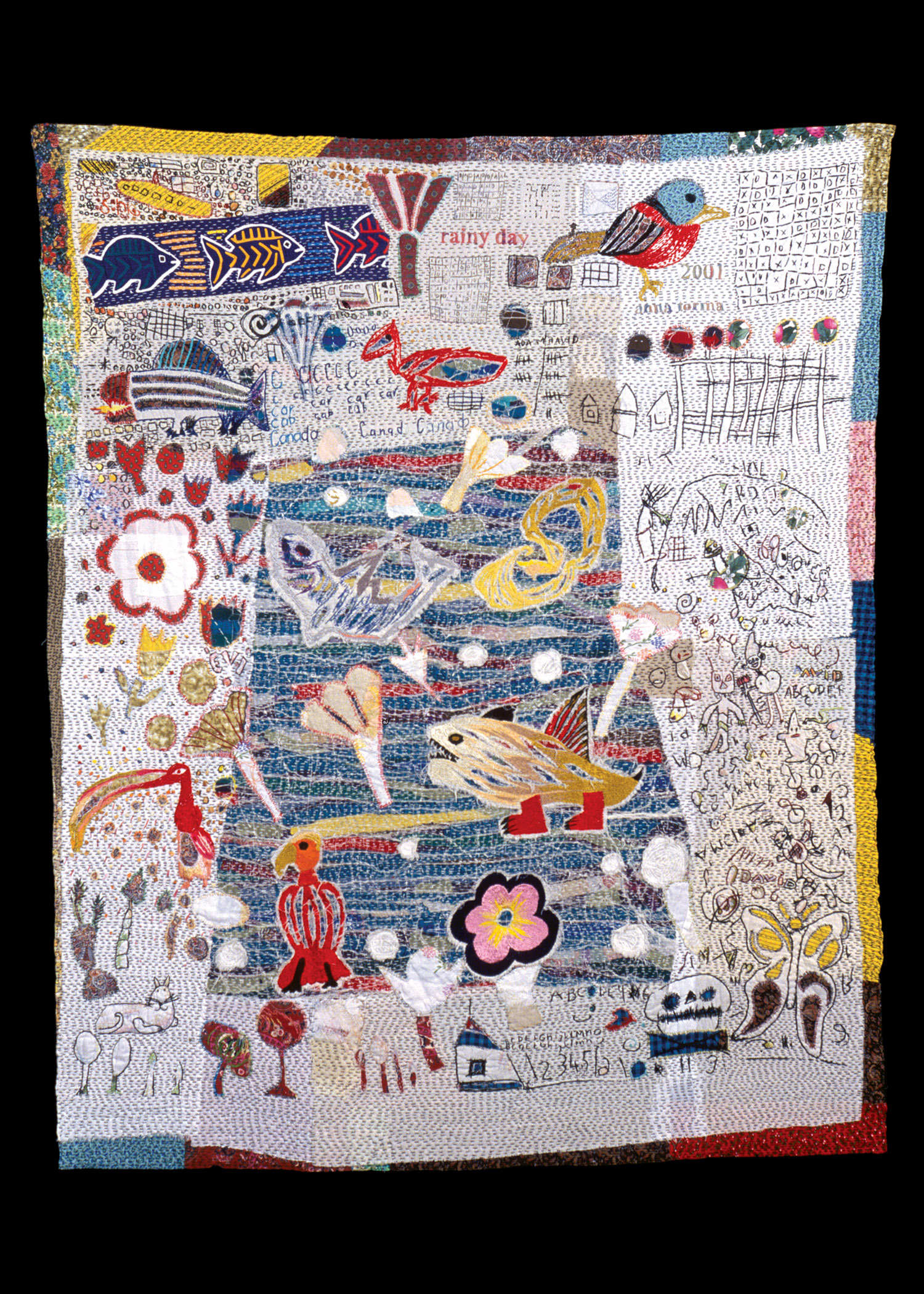When you feel like reading, you go to the library. Museums, on the other hand, are supposed to be for looking, but Bellevue Arts Museum’s Telling Tales: Narrative Works by Nate Steigenga, Cappy Thompson, and Anna Torma somewhat confounds that expectation. (Curated by Stefano Catalani, the show runs through Jan. 19.)
Two of the three artists are locals, and both were onsite to discuss their work during a press visit last month. Trained at Evergreen and Pilchuck, Thompson now works in Seattle, using medieval glass-painting techniques to render allegorical scenes that borrow from several religious traditions. At first glance, the works are like the stained glass in an old church, with saints and donkeys and Old Testament figures. Back when the Bible was illuminated for a largely illiterate public, its parables were rendered as pictographs that the priests might explain in their sermons. Here, Thompson invites you to look more closely, without clerical supervision, and you’ll find Hindu deities, Buddhist blossoms, and biographical snippets from her life—dogs and husbands, the struggle to have kids, and so forth.
Most of Thompson’s work isn’t actually transparent (unlike stained glass), but painted on glass in a flat, storybook style. Instead of “reading” her scenes from left to right, you can circle around a glass vessel, following these mini-narratives in a continuous cycle of life and death. Mythical and folkloric figures abound in Thompson’s very personal mythology. The works are, as they say, spiritual but not religious, comprising the diary of a pantheistic seeker.
Still drawing on the
walls shortly before the show’s opening was young artist Steigenga, whose intricate little collage scenes have been shown at Davidson Galleries on the other side of the lake. He often uses cheap found scraps—linen, wallpaper, drawer-liner paper—and cuts and tiles them into textured, cartoon-like tableaux. Everything in his gallery at BAM is new, created for the show, in an installation called The Illustrated History of the Beginning of Time. “I just decided to make up a religion,” says Steigenga, referring to several scenes of “these weird masked luchador figures on a safari.”
There’s a whimsical B-movie aspect to these small scenes, which Steigenga extends out of their frames by drawing on the walls. It’s folk art meets sci-fi, with just a hint of Wes Anderson twee. His small figures are given a texture like fish scales; there’s a bas relief effect when you view them closely from the side. While Thompson’s visual lexicon casts back through the centuries, Steigenga’s extends through the recent history of monster-movie matinees.
Hungarian-Canadian artist Torma is the outsider in this show. She weaves large textile installations, almost like quilts, that—like Thompson’s art—are full of personal themes and life details. Sometimes she even incorporates her children’s drawings in her dangling, woven displays. In examining them, there’s a feeling of voyeurism, like they’ve just been grabbed from the family linen closet.
More than in Thompson’s or Steigenga’s work, there is some actual reading to be done here. (There’s even some children’s math homework, too!) In her weaving we read, “One spring day, a pig and a mole and a frog met in the woods”; “I will not talk”; and “Who, may I ask, is the beast?”
These phrases are like the beginnings of fairy tales; one also feels the influence of folk art and Marc Chagall. And we see bears, monsters, and Adam and Eve—motifs from the collective unconscious that also appear in the Thompson and Steigenga galleries. Indeed it’s likely that all three artists, as children, had the same stories read to them at bedtime—the brothers Grimm, Ovid, and Dr. Seuss. Years later, those tales are interpolated into their adult lives.
Not part of the show but a shadowy cohort in an adjacent BAM gallery is Rick Araluce: The Minutes, the Hours, the Days (through Feb. 2). The local scenic designer for Seattle Opera specializes in fooling and guiding the eye, creating space and depth where there is none, suggesting opulence from humble materials. In a half-dozen installations, there’s a penny arcade/trompe l’oeil effect, as Araluce forces you to peer through keyholes and doorways, to bend low and look through a heating grate, to discern the hidden worlds within. (Recall the looking-through-the-radiator shot in Eraserhead.)
If the three artists show in Telling Tales create stories, Araluce creates mystery. He suggests absent drama, the proscenium without the play. Sound and light effects also give the illusion of depth and scale in what are mostly shoebox-sized theater spaces, numbering a half-dozen pieces (five newly created for BAM). If I prefer his work to that of the three artists above, that’s because it extends further off the page—away from text or tale and into the imagination.
bmiller@seattleweekly.com
BELLEVUE ARTS MUSEUM 510 Bellevue Way N.E., 425-519-0770, bellevuearts.org. $7–$10. 11 a.m.–5 p.m. Tues.–Sun.








